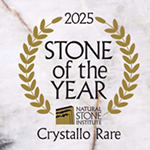Scientific versus Commercial Definition
Stones, and the minerals of which they are composed, have been studied with keen interest in the earth science fields for centuries. Geology is the study of the formation and history of the earth, while petrography is the study of rocks and the minerals of which they're made. Geologists and petrographers worldwide have defined hundreds of different rock types, based on their mineral composition, texture, and method of formation. Commercially, the use of the exact scientific rock definition would be a cumbersome and unnecessarily complicated practice. Furthermore, there are many rocks which are not clearly within one definition or another, but rather "straddling the fence" between two definitions. This point is further elaborated by the U.S. Geological Survey (USGS)1, Department of the Interior:
Scientific and commercial descriptions of various dimension stone types overlap. The scientific description of dimension stone types is focused primarily on the stone's geographic locality and mineralogical composition, whereas the commercial description is focused primarily on the locality and color of the stone. 2
Historically, it has been commercial practice to group stones within performance and behavioral groups as opposed to true scientific definition. This is recognized in several in ASTM International standards3. While scientifically there are hundreds of rock type identifications, only nine groups are commonly acknowledged commercially: Granite, Limestone, Marble, Onyx, Quartzite, Sandstone, Serpentine, Slate, Soapstone, and Travertine. This means that some rocks are included in groups which are not perfectly coincident with their scientific definition. High density and/or partially metamorphosed limestones, especially those capable of taking a polish, are oftentimes included in the marble group, because they appear, behave and perform more similarly to marble than to limestone. Most igneous rocks, such as gabbro, diabase, anorthosite, sodalite, gneiss, basalt, and many others are included in the granite group because they behave and perform similarly to granite. There are even a few non-igneous rocks (e.g. silicate-based conglomerates) that are commercially grouped with granites. Therefore, if you purchase a Crema Marfil "marble" vanity top, don't be surprised if your geologist friend visits your home and insists that it is limestone, because scientifically it is. Likewise, don't be surprised of the same geologist friend informs you that your Paradisio "granite" bar top and your Absolute Black "granite" kitchen island are really gneiss and gabbro respectively, because scientifically that's what they are.4 The key is performance. If a rock is sold within the granite group, the rock should be expected to have performance in that application that is similar, or in some cases superior, to that of a true granite.5
It is a fundamental position of the Marble Institute of America that there exists no such thing as a "bad stone". There do exist however, inappropriate selections for a given application, and also unrealistic expectations of a given stone type in a specific application. The informed selection of natural stone products is also influenced by the tastes of the end user. To some, natural wear, etching, or weathering bring about a hidden charm, or natural "patina" as the stone displays signs of its yielding to the forces encountered in its service. To others, the only acceptable performance is for the stone to maintain its pristine, "as new" look for the entire duration of its service life. Selections of natural stone types are available to satisfy both users, but the proper research must be completed to assure that the selected stone will perform in service with the desired behavior.












